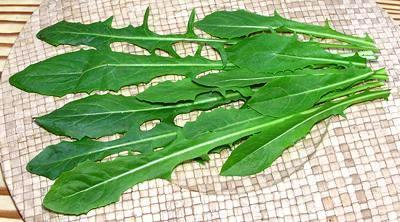 [Dent-de-lion (Old French), Pissenlit (French), Taraxacum officinale]
[Dent-de-lion (Old French), Pissenlit (French), Taraxacum officinale]
Originating in Eurasia and now infesting lawns worldwide, this common weed is a highly successful member of the vast daisy family (Asteraceae). Its long taproot makes it very difficult to eradicate and its efficient windblown seed dispersal system assures reinfection. It prefers temperate climate and moist soil, which is why it has such an affinity for lawns. The photo specimen leaves were up to 14 inches long. but they are sold up to around 16 inches.
The plant has both medicinal and culinary value. Young leaves are used raw in salads while older ones are more often cooked or added to soups. . Under their bitterness the leaves have considerable sweetness and have a particular affinity for eggs. Roots are used, as are chicory roots, to make a coffee substitute, and flower heads are used to make dandelion wine. The leaves are a strong diuretic, thus the French name Pissenlit (wet the bed). Herbalists consider dandelion a general tonic and "blood cleanser".
More on Lettuce & Chicory
More on Daisy Herbs & Flowers
Sometimes a variety of chicory, heads of large dandelion-like leaves
with thick white stems, is sold as dandelion or "Italian dandelion". Real
dandelion leaves are always separate (unless sold attached to the root)
and smaller with thin stems. The chicory is, however, quite similar
(and closely related)
dy_dandez 090111 - www.clovegarden.com
©Andrew Grygus - agryg@clovegarden.com - Photos
on this page not otherwise credited © cg1
- Linking to and non-commercial use of this page permitted